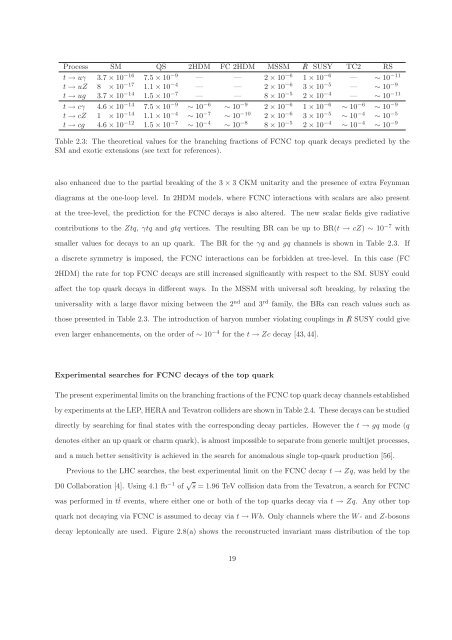CERN-THESIS-2012-153 26/07/2012 - CERN Document Server
CERN-THESIS-2012-153 26/07/2012 - CERN Document Server
CERN-THESIS-2012-153 26/07/2012 - CERN Document Server
You also want an ePaper? Increase the reach of your titles
YUMPU automatically turns print PDFs into web optimized ePapers that Google loves.
Process SM QS 2HDM FC 2HDM MSSM /R SUSY TC2 RS<br />
t → uγ 3.7 × 10 −16 7.5 × 10 −9 — — 2 × 10 −6 1 × 10 −6 — ∼ 10 −11<br />
t → uZ 8 × 10 −17 1.1 × 10 −4 — — 2 × 10 −6 3 × 10 −5 — ∼ 10 −9<br />
t → ug 3.7 × 10 −14 1.5 × 10 −7 — — 8 × 10 −5 2 × 10 −4 — ∼ 10 −11<br />
t → cγ 4.6 × 10 −14 7.5 × 10 −9 ∼ 10 −6 ∼ 10 −9 2 × 10 −6 1 × 10 −6 ∼ 10 −6 ∼ 10 −9<br />
t → cZ 1 × 10 −14 1.1 × 10 −4 ∼ 10 −7 ∼ 10 −10 2 × 10 −6 3 × 10 −5 ∼ 10 −4 ∼ 10 −5<br />
t → cg 4.6 × 10 −12 1.5 × 10 −7 ∼ 10 −4 ∼ 10 −8 8 × 10 −5 2 × 10 −4 ∼ 10 −4 ∼ 10 −9<br />
Table 2.3: The theoretical values for the branching fractions of FCNC top quark decays predicted by the<br />
SM and exotic extensions (see text for references).<br />
also enhanced due to the partial breaking of the 3 × 3 CKM unitarity and the presence of extra Feynman<br />
diagrams at the one-loop level. In 2HDM models, where FCNC interactions with scalars are also present<br />
at the tree-level, the prediction for the FCNC decays is also altered. The new scalar fields give radiative<br />
contributions to the Ztq, γtq and gtq vertices. The resulting BR can be up to BR(t → cZ) ∼ 10 −7 with<br />
smaller values for decays to an up quark. The BR for the γq and gq channels is shown in Table 2.3. If<br />
a discrete symmetry is imposed, the FCNC interactions can be forbidden at tree-level. In this case (FC<br />
2HDM) the rate for top FCNC decays are still increased significantly with respect to the SM. SUSY could<br />
affect the top quark decays in different ways. In the MSSM with universal soft breaking, by relaxing the<br />
universality with a large flavor mixing between the 2 nd and 3 rd family, the BRs can reach values such as<br />
those presented in Table 2.3. The introduction of baryon number violating couplings in /R SUSY could give<br />
even larger enhancements, on the order of ∼ 10 −4 for the t → Zc decay [43,44].<br />
Experimental searches for FCNC decays of the top quark<br />
The present experimental limits on the branching fractions of the FCNC top quark decay channels established<br />
by experiments at the LEP, HERA and Tevatron colliders are shown in Table 2.4. These decays can be studied<br />
directly by searching for final states with the corresponding decay particles. However the t → gq mode (q<br />
denotes either an up quark or charm quark), is almost impossible to separate from generic multijet processes,<br />
and a much better sensitivity is achieved in the search for anomalous single top-quark production [56].<br />
Previous to the LHC searches, the best experimental limit on the FCNC decay t → Zq, was held by the<br />
D0 Collaboration [4]. Using 4.1 fb −1 of √ s = 1.96 TeV collision data from the Tevatron, a search for FCNC<br />
was performed in t¯t events, where either one or both of the top quarks decay via t → Zq. Any other top<br />
quark not decaying via FCNC is assumed to decay via t → Wb. Only channels where the W- and Z-bosons<br />
decay leptonically are used. Figure 2.8(a) shows the reconstructed invariant mass distribution of the top<br />
19















